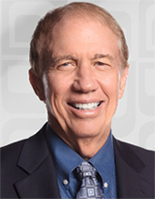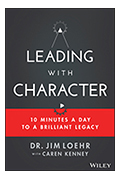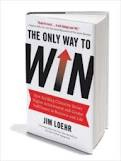Our Academy:
Leading with Character
Jim Loehr

For many years at the Human Performance Institute, we operated a small tennis academy for juniors, aged 9 to 18. The tennis program's goal was to leverage all the demands and stresses of elite junior tennis to build, first and foremost, muscles of character.
The objective was to repurpose all the disappointment, hard work, uncertainty, injuries, wins, losses, and more to build in each young athlete muscles of honesty, integrity, respect, humility, kindness, resiliency, and confidence. While the players were myelinating the motor pathways for their forehands, backhands,serves, and volleys, they were also myelinating the character pathways for engagement, generosity, positivity, and gratitude.
Character Muscles
Each day, players selected a specific Character Muscle they wanted to strengthen. Building the targeted muscle happened by acting it out on court, thinking about it, and writing daily in a character journal.
The player's highest priority every day in practice and competition was not winning or achieving a certain strict performance goal but determining who they were becoming because of the demands of tennis.
We called our approach "intentional adaptation." Human beings are always adapting to their environments, but sometimes it's to the detriment of their character. Our coaching staff was committed to intentional adaptation, to building character in the players and not allowing their developing character to be hijacked by their pursuit of tennis fame.
The results? Our players became extraordinary competitors as judged by their national rankings and university scholarships-- but, far more importantly, they experienced significant character growth as judged by the players themselves, their parents, and their coaches.

The Chase
We human beings love to chase. We frequently don't stop to ask ourselves, mid-chase, critical questions, such as:
1. What am I chasing?
2. Why am I chasing it?
3. Who am I--and who are those I lead-- becoming as a consequence of the chase?
The answers to the first two questions are best thought of, from all the evidence, as self-determined, not pre-determined and are immutable. These questions bring us face to face with our central purpose for living.
Most important is the third question. When our grand purpose for living is more about serving others than ourselves, or when we focus what we do primarily to serve others, it matters less what we're chasing, or what we do to make a living.
In the words of the former tennis great Arthur Ashe, "From what we get, we can make a living. From what we give, we can make a life." Our treatment of others is invariably the calculus we use for becoming our best self.
And to make this happen, the muscles of morality can be trained and balanced in the same way that we train physical muscles. Issues of muscle balance, muscle size, synergy, reciprocal inhibition, and the concepts of agonist and antagonist apply to both worlds.

For all sad words of tongue or pen, the saddest are these, ''It might have been."-John Greenleaf Whittier.
Joseph Campbell, the American mythologist and author of numerous books, including the classic The Power of Myth. He spent his life exploring common elements of humanity.
For Campbell, a universal thread in the story of humanity is the endless struggle between good and evil. George Lucas, creator of Star Wars, sought advice from Campbell in writing the epic story that would capture the hearts and minds of legions of viewers, young and old.
The Star Wars story depicts the universal battle of life as one between the forces of good, represented by the Jedi and Yoda, and the forces of evil, represented by Darth Vader, the Stormtroopers, and others.
As we develop and become wiser, we recognize that evil dwells not as a force in the external world but within us. Darth Vader, symbol of evil, lies dormant inside each of us, just waiting to be summoned.
In reality, the battle is me against myself, Me as my Selfish, Ego-Centered Self versus Me as my Best Moral Self. The hero's journey is a call to align our life more fully with our higher nature, our core values and sense of goodness.

When we accept the call, we agree to engage in an often fierce battle between the forces of weakness and those of strength (our Yoda).
The power of Yoda is cultivated through dedicated training and effort. Eventually, if we refuse to surrender, we will slay the inner demon, emerging stronger and more prepared for a life of service to others.
Again according to Arthur Ashe, "True heroism is remarkably sober, very undramatic. It is not the urge to surpass all others at whatever cost, but the urge to serve others at whatever cost."
Every successful battle is followed by a brief celebratory moment and then suddenly we are awakened, yet again, by another call to heroism,a call to go into battle and slay one more personal demon. As long as we accept the call to confront our moral weaknesses, our hero's journey will continue until our last day.
The main protagonists in the Star Wars universe were the Jedi knights, an order devoted to citizenship, acts of charity, and volunteerism. Their mission was always to help and protect those in need, particularly the helpless.
Leading with Character

What does it mean to lead with character? It is founded on the idea of treating others the way we want to be treated; putting the welfare of others before our own; making how we treat others in the chase to the top more important than getting to the top.
For coaches and all leaders, the most important takeaway is that we are all vulnerable to lapses in character, with potentially disastrous consequences.
Yet each of us possesses the power to intentionally convert moral weakness into strength. Although every day we witness good men and women falling from grace, we also witness leaders who refuse to take moral shortcuts, refuse to compromise their character to succeed and win.
Daily moral strength training, as we did at our academy, is a powerful, viable answer. And, as we have explored, by leading with character, we not only help our fellow human beings; we get to know what it is to live a truly successful life. We maximize our happiness and sense of well-being. In our treatment of others, we are not just leaving a brilliant legacy for after we are gone; we are creating a brilliant legacy in the here and now.
As the 19th century theologian Tryon Edwards put it: "Thoughts lead on to purposes; purposes go forth in action; actions form habits; habits decide character; and character fixes our destiny."






